Vision 2025 - National Research Centre for Grapes
Vision 2025 - National Research Centre for Grapes
Vision 2025 - National Research Centre for Grapes
You also want an ePaper? Increase the reach of your titles
YUMPU automatically turns print PDFs into web optimized ePapers that Google loves.
5. IMPACT ASSESSMENT ON FUTURE RESEACRH<br />
5.1 GROWTH<br />
5.1.1 Crop Improvement<br />
Germplasm collection of 415 accessions which includes rootstock species, various table and<br />
wine grape varieties / hybrids and wild species at the <strong>Centre</strong> is going to make an important<br />
impact <strong>for</strong> the development of plant material of desirable traits to meet the requirements of<br />
grape industry. So far, Dogridge rootstock has been recommended <strong>for</strong> cultivation under the soil<br />
/ water salinity and drought conditions and accepted very well by the grape growers all over<br />
the country. About more than 1000 ha area has come under this rootstock and all upcoming<br />
areas are covered with this rootstock. With regard to grape varieties <strong>for</strong> table purpose and<br />
raisin making Thompson Seedless and its clones identified by the growers viz. Tas-A-Ganesh,<br />
Sonaka, Chaman and among coloured varieties, Sharad Seedless, a clone of introduced<br />
Kishmish Chernyi has replaced all conventional varieties like Anab-e-Shahi, Bangalore Blue<br />
and Gulabi. Flame Seedless has also been accepted in some areas. Introduced wine varieties<br />
viz. Sauvignon Blanc, Chenin Blanc, Ugni Blanc, Chardonnay, Viognier and Clairette among<br />
white varieties and Cabernet Sauvignon, Shiraz, Merlot, Zinfandel among the red wine have<br />
been accepted by wineries in the country. Computer software developed <strong>for</strong> germplasm<br />
collection will find a way <strong>for</strong> knowing all the available germplasm in the country with their<br />
genetic and other traits. Biotechnological work initiated at this <strong>Centre</strong> is going to make an<br />
impact in identification of genetic purity of different varieties and rootstocks and marker<br />
assisted selection <strong>for</strong> the development of plant material with all desirable traits.<br />
5.1.2 Crop Production<br />
Newer treatments of bio-regulators, pot filling, grafting and its growth stages suggested in<br />
raising the plant in nursery so far and in the field were accepted by the grape growers and<br />
looking <strong>for</strong> still better and efficient methods to reduce the initial period of gestation <strong>for</strong> setting<br />
up of vineyard. Training methods <strong>for</strong> vineyard development is yet to make uni<strong>for</strong>m impact and<br />
there is a lot of variation in design and fabrication material used. Pruning practices suggested<br />
in different varieties as per the period of crop harvest were also accepted by the growers by<br />
making some modifications to suit their requirement. Use of bud breaking chemicals <strong>for</strong><br />
uni<strong>for</strong>m bud sprout, stage and various concentrations of bioregulators and stage of their<br />
application to increase yield and quality of table grapes is widely practiced. Other cultural<br />
practices like retention of shoots and bunches per unit area, leaf area per shoot are being<br />
adopted by majority of the grape growers to produce good quality grapes.<br />
Dogridge rootstock and its compatibility with Thompson Seedless and its clones has been<br />
established and accepted by the grape growers under the soil and water salinity and drought<br />
conditions. Leaf petiole analysis at bud differentiation and flowering stage <strong>for</strong> knowing the<br />
status of nutrients and their right quantity application in terms of nitrogen, phosphorus and<br />
potassium has made much impact in application of fertilizers. In addition to this, the technique<br />
of fertigation to increase the fertilizer efficiency developed by the <strong>Centre</strong> is being transferred<br />
through various extension methods including the technical bulletins and folders. Drip<br />
irrigation method has been well received and all grape area is presently covered under this<br />
method. To increase further the efficiency of water among grape growers by suggesting the<br />
phenological stages of vine vis-à-vis the water requirement has been accepted besides the other<br />
methods such as use of mulches, use of various rootstocks and antistress chemicals.<br />
13





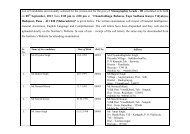
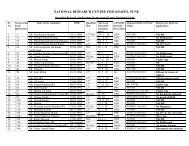

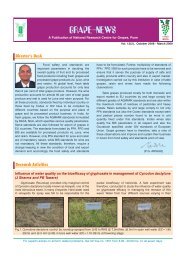

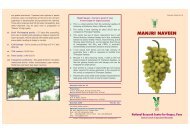
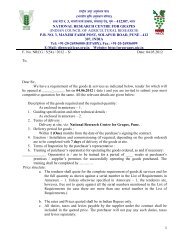



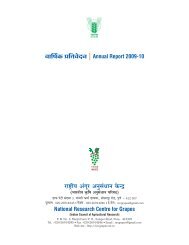
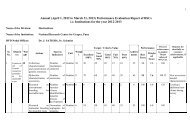
![mj]mJ{V cmcH$m{irM{ (_mBQâ¤>g) oZ`ÃÃU](https://img.yumpu.com/33367555/1/190x127/mjmjv-cmchmirm-mbqag-ozaau.jpg?quality=85)